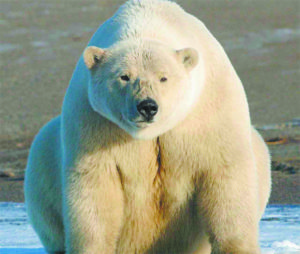
 Although people who read The Oregonian might believe differently, conservation efforts over the last few decades have greatly benefited the iconic symbol of the far north: polar bears. Their numbers have increased dramatically since the signing of an international agreement in 1973 to eliminate commercial and sport hunting. The uncontrolled slaughter of these magnificent animals and many other marine mammals has led to a great resurgence. Canadian biologist Dr. Susan Crockford estimates that polar bears now number about 30,000. They are well distributed across all of their 19 Arctic habitats. Such a wide distribution is further evidence of a healthy population.
Although people who read The Oregonian might believe differently, conservation efforts over the last few decades have greatly benefited the iconic symbol of the far north: polar bears. Their numbers have increased dramatically since the signing of an international agreement in 1973 to eliminate commercial and sport hunting. The uncontrolled slaughter of these magnificent animals and many other marine mammals has led to a great resurgence. Canadian biologist Dr. Susan Crockford estimates that polar bears now number about 30,000. They are well distributed across all of their 19 Arctic habitats. Such a wide distribution is further evidence of a healthy population.
 The good news is not limited to polar bears. All eight species of fur seals, both species of elephant seals, walruses, sea otters, and all species of whales (including gray, right, bowhead, humpback, sei, fin, blue, and sperm whales) have made strong comebacks. And of course, a large population of seals benefits polar bears, because seals are their favorite food.
The good news is not limited to polar bears. All eight species of fur seals, both species of elephant seals, walruses, sea otters, and all species of whales (including gray, right, bowhead, humpback, sei, fin, blue, and sperm whales) have made strong comebacks. And of course, a large population of seals benefits polar bears, because seals are their favorite food.
The famous British journalist and PhD zoologist Matt Ridley tells of his own experience with polar bears. When he and friends visited Spitsbergen Island in the Arctic Ocean far north of Scandinavia in 1978, they thought nothing of camping out in the open and using a small cabin. There was no danger from polar bears, because they never saw any. But when he inquired about making a return visit a few years ago, he was told that the cabin had been destroyed by the bears, and the bears had decimated the vast flocks of nesting geese by eating their eggs. Bears will eat practically anything.
In the early 1970s, I spent time at the Churchill Research Range in Northern Manitoba along Hudson Bay. That area has the southern-most polar bear population. When the bears were migrating through the area, everyone was required to remain inside, lest we become the bear’s next dinner. Occasionally, a bear would amble through town and make a meal of one of the sled dogs tied up outside. He might then go to the garbage dump outside of town looking for a little dessert.
Life is tough in the far north, requiring adaptability. Polar bears especially need food in the spring after hibernating all winter. Then they can go through the summer with little food until the ice returns in the Fall and makes hunting easier again. They need to store away a lot of fat to make it through the very harsh winter. If inappropriate weather conditions interfere with this feeding cycle, bears will perish.
Such a situation occurred between 1998 and 2004 with an earlier breakup of pack ice in Hudson Bay, leading to a drop of 22% in the local bear population. Since then, the pack ice has held together longer, and the bear population has rebounded.
But this is far from the only or worst climate dynamic affecting polar bear populations. In 1974, there was a catastrophic decline in the bear population in the Eastern Beaufort Sea north of Alaska. It was associated with extremely thick ice that decimated the seal population by 80% and consequently the polar bears that depend on them for food.
In all of these situations, the polar bear population rebounded within a few years. This says that these bears, which have been around for thousands of years, are a very resilient species. They can survive the substantial variability in Arctic conditions that are a fact of life on a year-to-year and decade-to- decade basis. That also means surviving the far greater climate variations associated with Ice Ages. Polar bears have survived the extreme cold of an Ice Age as well as the considerably warmer conditions this planet experienced a few thousand years ago during the Holocene Climate Optimum.
This is the best level-headed polar bear science that we have today.
Of course, it is very far from what the climate cult at The Oregonian would have you believe. Their recent series on “Nora,” the zoo polar bear was supposed to be a wakeup call about the plight of polar bears in the wild. Zoo animals have far different problems than bears in the wild, because zoos are unable to recreate enough of an arctic environment to satisfy the needs of these animals. So Nora’s problems are hardly analogous to anything in the wild, and a far cry from our own fate on this planet.
But this does not keep Oregonian Editor Mark Katches from saying that his five-part series on Nora “explores how our fate intersects with polar bears as our climate changes and the Arctic sea ice dwindles.” He goes on to say “We built [Project Nora] with kids in mind because, if our generation can’t get things right, perhaps the next generation will.” That is probably the most ominous comment in the entire series. The series is pure propaganda aimed at children. Propagandizing children is very very wrong.
Effective propaganda always includes some shreds of truth to convince the young and gullible that it is believable. In this case, it is true that the Arctic has warmed more than any other region on the planet, about four degrees Fahrenheit since 1980. What The Oregonian will never mention is that we saw a similar warm up from 1915 to 1940 and to a similar peak. In other words, the Arctic climate is hardly different today than it was in 1940. It cycled back to cold after 1940, as the Pacific Ocean driving it typically does. The Arctic, with its low angle to no sunlight, is dependent on regular deliveries of ocean and atmospheric heat from lower latitudes. When those falter, the region turns colder.
And The Oregonian will never mention that the climate at the other end of the earth in Antarctica did not similarly warm after 1980. NASA satellite temperature data show no warming trend at all since 1980, suggesting that the “Global” in “Global Warming” is pure larceny. Again, Mother Nature (via ocean cycles) is in firm control.
Story telling is the bread and butter of journalism. While all of us love a story about an appealing bear, we expect those stories that are rooted in science to be true. The Oregonian’s story about Nora was likely true but their extension into climate science was cynical nonsense rooted in politics; and deception, not authoritative science.
Look at the conclusion from their five-part series: “Global climate change is caused by increases in carbon dioxide and other heat-trapping gases in the Earth’s atmosphere. The accumulation of these gases has caused the Earth’s temperature to rise at the fastest rate in recorded history over the last 50 years, according to the Natural Resources Defense Council. And experts think the pace is accelerating.”
There is so much nonsense, ignorance, and fraud in that conclusion that The Oregonian should be thoroughly ashamed. Climate change has many natural origins, from the terrestrial to the extraterrestrial. Man-made carbon dioxide is a very minor player. Our oceans and atmosphere are major players, because they are never in complete equilibrium. Solar cycles and orbital changes caused by the planet Jupiter are also major players. Water vapor is the major climate gas, not carbon dioxide.
And the Natural Resources Defense Council that The Oregonian cites as their scientific source for alarm is hardly authoritative. They are a group of lawyers, without ANY scientific credentials that I could find. That fits well with The Oregonian that similarly has no scientific expertise either. Their main reporter for this series (Kale Williams) was a house painter before landing a job at the newspaper.
This Thanksgiving we should be thankful that the iconic symbol of the far north is doing just fine in a very harsh and very unforgiving environment. We should also be thankful that there are newspapers like The Northwest Connection that will still print the scientific truth as best we know it from real scientists NOT real lawyers.
Gordon J. Fulks lives in Corbett and can be reached at gordonfulks@hotmail.com. He holds a doctorate in physics from the University of Chicago’s Laboratory for Astrophysics and Space Research.
(Unless otherwise noted, the opinions expressed are the author’s and do not necessarily reflect the views of the Northwest Connection.)
No Comments
Leave a comment Cancel